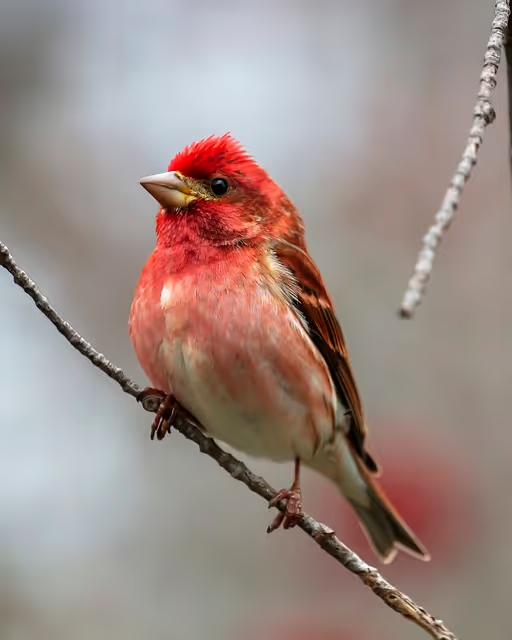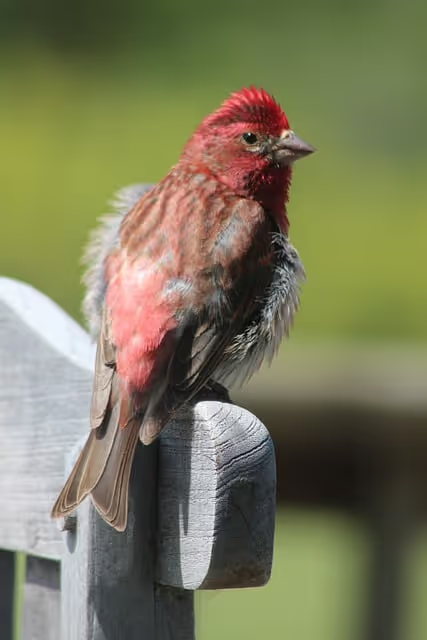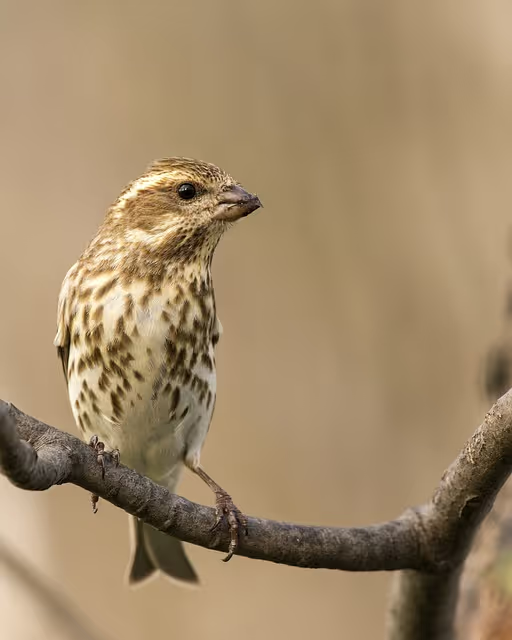Purple Finches


Introduction and Color Scheme
When I first laid eyes on a Purple Finch (Haemorhous purpureus), I honestly didn’t believe that was a Purple Finch. It was indeed a finch, but there wasn’t a hint of purple on it. Instead, it had a beautiful shade of pinkish-red. I surmised that I must have been looking at a red finch (Haemorhous mexicanus, more commonly known as a House Finch). However, when I later went online and began studying photos of finches, I quickly realized that I had indeed been looking at a Purple Finch. It’s just that Purple Finches don’t have any purple on them. Male Purple Finches may give the appearance of having purple on them when viewed from afar. However, a closer look reveals the distinct pinkish-red shade on the bird’s head and breast (2). Males also have brown on their backs and a cloudy shade of white on their bellies (2). Female Purple Finches have no purple, pink, or red on them at all. Instead, they have coarse streaks on their bodies and several facial marking, including a dark line running down the side of their throats, and a whitish colored eye-stripe (2). The lack of purple does not detract from the Purple Finch’s striking appearance. They are beautiful birds that are sure to bring a smile to anyone who spots one.
Size and Shape
Compared to most small forest birds, Purple Finches are chunky and large. Their conical beaks are larger than those of any sparrow (2). Their tails are relatively short and clearly notched at the tip (2). Members of both sexes weigh anywhere from 0.6 to 1.1 ounces (18 to 32 grams), have a wingspan of 8.7 to 10.2 inches (22 to 26 centimeters), and are 4.7 to 6.3 inches long (12 to 16 centimeters) (2).
Range
Purple Finches can be seen across wide swaths of North America, depending on what time of year it is. They can be seen year-round across most of Western Washington, Western Oregon, Vancouver Island, Coastal California, most of the Southwestern British Columbia mainland, and some of the mountainous areas of Northern and Central California (3). They can also be spotted throughout the entire year in New York, New England, and in parts of Pennsylvania, Ohio, West Virginia, Michigan, Ontario, Quebec, Atlantic Canada, and Wisconsin (3).
During the breeding season, Purple Finches can be seen across much of Northern and Central Canada (3). During the winter, they make themselves present in a large swath of United States, stretching from the Great Plains to the Atlantic Ocean (3). Some members of the species also take up residence in parts of the Cascades, Baja California, and in California’s Central Valley when the weather turns colder (3).

Diet and Feeding Behavior
Purple Finches are primarily seedeaters. They particularly like black oil sunflower seeds (2), but will also eat various tree seeds, including those from elms and conifers (1). Additionally, they will eat grass seed, plant seeds, poison ivy (which is not poisonous to them), honeysuckle, tree buds, berries, and small fruits (blackberries, cherries, and apricots are among their favorites) (1). During the summer, some insects, such as grasshoppers, beetles, and caterpillars, are also eaten (1).
Like most birds, Purple Finches forage for their food. They mostly look for seeds and insects in high trees, shrubs, and weedy fields (3). They often forage high up in the trees, and away from the ground (1). During the winter months, they will descend from the trees and forage for seeds on the ground (3). Purple Finches also like coming to bird feeders (3). During nesting season, Purple Finches may be solo foragers. Outside of nesting season, Purple Finches may forage in small flocks (3).
Sometimes, Purple Finches can become agitated during the foraging process (1), especially if another bird is eyeing the same item of food. During a dispute, the bird will lean toward its opponent with its neck stretched out and its bill pointed at the other bird (1). If this isn’t enough to fend off the opponent, the bird may intensify the situation by standing upright, opening its beak, and pointing its bill at the other bird in a downward fashion (1). Should this fail to resolve the conflict, a pecking attack may ensue (1). Regardless of how far these encounters go, they normally end with the female winning and the male losing (1).
Habitat
Purple Finches make their homes in a variety of habitats, including woods, suburbs, and groves. They mostly breed in coniferous and mixed woods, both along the edges of forests and in the forest interior (3). In the west coast states, they may also breed in streamside trees and in areas of oak woodland (3). During their annual migration period, as well as in the winter, Purple Finches may also be found living in swamps and overgrown fields (3).

Courtship and Nesting
When it comes time to form bonded pairs, male Purple Finches will attempt to attract females by hopping near them (3). While doing this, they have their wings drooping, tails raised, and chests puffed out (3). They then proceed to vibrate their wings until they rise a short distance into the air (3). They may hold bits of nesting materials in their bills, and perform soft songs during these performances (3).
Once bonded pairs are formed, construction of the nest begins in earnest. The nest is normally placed on a horizontal branch or fork of a tree (3). Deciduous trees are used for nesting sites in the west, while conifer trees are used in the east (3). The nest is placed “well out” from the trunk (3). The reason they do this is simply out of preference. Purple Finches prefer to make their nests at the far end of long branches (4), even though the far end of branches may offer less stability and privacy when compared to the near end (the end of the branch that is closest to the tree trunk) of branches.
The nest is normally positioned about 15 to 20 feet above the ground. However, it can be closer to the ground or as high as 50 feet in the air, if needed (3). Construction of the nest is believed to be mostly carried out by the female (3). It is typically a compact open cup that is made out of rootlets, weeds, twigs, and strips of bark. It is then lined with moss, animal hair, and fine grasses (3). The nest takes anywhere from three to eight days to build, and is normally about seven inches wide and four inches tall (1).
Eggs and the Young
Purple Finches produce at least one brood of youngsters per year, though it is believed that they might have two broods per year in the Pacific Coast region (3). They normally lay four to five eggs at a time. The eggs are pale greenish-blue in color, and marked with black and brown spots and/or blotches (3). The incubation process is handled exclusively by the female, and runs for about two weeks (3). When the nestlings hatch, both parents share the responsibility of feeding them (3). This responsibility doesn’t last long though, as the young leave the nest only about two weeks after hatching (3).
References
© Ian Caldwell, April 2024
Touch whale bones, examine shipwreck artifacts and connect with the coast's living history.

Support our mission, get involved in educational programs, or contribute through donations and volunteering.